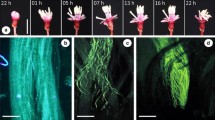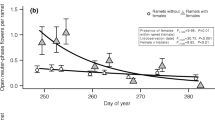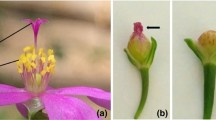Abstract
After several decades of research, dynamics and patterns of mating system in floral evolution remain incompletely understood, especially with regards to strategies that combine both outcrossing and selfing, as frequently recorded in the genus Campanula. Data about temporal and spatial dynamics of secondary pollen presentation are still scarce in literature: we investigated them using Campanula medium (Campanulaceae) as case study. Experimental pollinations were conducted under natural conditions, to characterise the breeding system of this species. Effects on stigma opening and stigma receptivity of stylar pollen presence were investigated in manipulated flowers. The temporal dynamics and fitness of male and female functional phases were estimated. Flower visitors and their interactions with sexual parts of the flower were also annotated. C. medium is xenogamous and self-incompatible, with a clear temporal separation between sexual functional phases. Floral lifespan is shortened by experimental outcrossing. Removal of pollen from the style shortened the time span of male function. Pollen viability was highest at the beginning of the anthesis, decreasing during the flowering period, whereas stigmatic receptivity shows an opposite trend. We found a severe pollen limitation in the studied population. Bees were the most frequent floral visitors. In some of these insects we observed stereotyped interactions with the reproductive structures of the flower, in particular with the pollen, exposed along the upper and median portion of the style. Sexual phases in C. medium are inversely correlated and finely spatially and temporally coordinated, since stigma maturation is scalar along its length and depends on pollen presence on the style. Overall, our findings push forward the knowledge on reproductive strategies in Campanula.






Similar content being viewed by others
References
Ashman TL, Schoen DJ (1996) Floral longevity: fitness consequences and resource costs. In: Lloyd DG, Barrett SCH (eds) Floral biology. Chapman and Hall, New York
Ashman TL, Knight TM, Steets JA, Amarasekare P, Burd M, Burd M, Campbell DR, Dudash MR, Johnston MO, Mazer SJ, Mitchell RJ, Morgan MT, Wilson WG (2004) Pollen limitation of plant reproduction: ecological and evolutionary causes and consequences. Ecology 85:2408–2421
Astuti G, Roma-Marzio F, D’Antraccoli M, Bedini G, Carta A, Sebastiani F, Bruschi P, Peruzzi L (2017) Conservation biology of the last Italian population of Cistus laurifolius (Cistaceae): demographic structure, genetics and reproductive success. Nat Conserv 22:169–190
Astuti G, Bedini G, Carta A, Roma-Marzio F, Trinco A, Peruzzi L (2018) Comparative assessment of reproductive traits across different habitats in the endangered Webb’s hyacinth (Bellevalia webbiana Parl.). Nat Conserv 24:81–92
Barrett SCH (2002) The evolution of plant sexual diversity. Nat Rev Genet 3:274–284
Barrett SCH (2003) Mating strategies in flowering plants: the outcrossing–selfing paradigm and beyond. Philos Trans R Soc Lond Ser B 358:991–1004
Bartolucci F, Peruzzi L, Galasso G, Albano A, Alessandrini A, Ardenghi NMG, Astuti G, Bacchetta G, Ballelli S, Banfi E, Barberis G, Bernardo L, Bouvet D, Bovio M, Cecchi L, Di Pietro R, Domina G, Fascetti S, Fenu G, Festi F, Foggi B, Gallo L, Gubellini L, Gottschlich G, Iamonico D, Iberite M, Jinénez-Mejías P, Lattanzi E, Martinetto E, Masin RR, Medagli P, Passalacqua NG, Peccenini S, Pennesi R, Pierini B, Poldini L, Prosser F, Raimondo FM, Marchetti D, Roma-Marzio F, Rosati L, Santangelo A, Scoppola A, Scortegagna S, Selvaggi A, Selvi F, Soldano A, Stinca A, Wagensommer RP, Wilhalm T, Conti F (2018) An updated checklist of the vascular flora native to Italy. Plant Biosyst 152:179–303
Bertin RI, Sullivan M (1988) Pollen interference and cryptic self-fertility in Campsis radicans. Am J Bot 75:1140–1147
Bielawska H (1964) Self fertilization in Campanula rotundifolia L. s.1. group. Acta Soc Bot Pol 42:253–264
Bingham RA, Orthner AR (1998) Efficient pollination of plants. Nature 391:238–239
Blionis GJ, Vokou D (2001) Pollination ecology of Campanula species on Mt Olympos. Greece Ecography 24:287–297
Bosma T, Dole JM (2002) Postharvest handling of cut Campanula medium flowers. Hort Sci 37:954–958
Broyles SB, Wyatt R (1993) The consequences of self-pollination in Ascelpias exaltata, a self-incompatible milkweed. Am J Bot 80:41–44
Burd M (1994) Bateman’s principle and plant reproduction- the role of pollen limitation in fruit and seed set. Bot Rev 60:83–139
Carrió E, Güemes J (2013) The role of a mixed mating system in the reproduction of a Mediterranean subshrub (Fumana hispidula, Cistaceae). J Plant Res 126:33–40
Castro S, Silveira P, Navarro L (2008) How flower biology and breeding system affect the reproductive success of the narrow endemic Polygala vayredae Costa (Polygalaceae). Bot J Linn Soc 157:67–81
Cavins TJ, Dole JM (2001) Photoperiod, juvenility, and high intensity lighting affect flowering and cut stem quality of Campanula and Lupinus. Hort Sci 36:1192–1196
Charlesworth D, Charlesworth B (1987) Inbreeding depression and its evolutionary consequences. Annu Rev Ecol Evol Syst 18:237–268
Dafni A, Motte Maués M (1998) A rapid and simple procedure to determine stigma receptivity. Sex Plant Reprod 11:177–180
Dafni A, Kevan PG, Husband BC (2005) Practical pollination biology. Enviroquest, Ontario
Endress PK (1994) Diversity and evolutionary biology of tropical flowers. Cambridge University Press, Cambridge
Evanhoe L, Galloway LF (2002) Floral longevity in Campanula americana (Campanulaceae): a comparison of morphological and functional gender phases. Am J Bot 89:587–591
Faegri K, van der Pijl L (1979) The principles of pollination ecology. Pergamon Press, Oxford
Fan YL, Kress WJ, Li QJ (2015) A new secondary pollen presentation mechanism from a wild ginger (Zingiber densissimum) and its functional roles in pollination process. PLoS One 10:e0143812
Galen C, Gregory T, Galloway LF (1989) Costs of self-pollination in a self-incompatible plant, Polemonium viscosum. Am J Bot 76:1675–1680
Galloway LF, Cirigliano T, Gremski K (2002) The contribution of display size and dichogamy to potential geitonogamy in Campanula americana. Int J Plant Sci 163:133–139
Goodwillie C, Kalisz S, Eckert CG (2005) The evolutionary enigma of mixed mating systems in plants: occurrence, theoretical explanations, and empirical evidence. Ann Rev Ecol Evol Syst 36:47–79
Guitián J, Navarro L (1996) Allocation of reproductive resources within inflorescences of Petrocoptis grandiflora (Caryophyllaceae). Can J Bot 74:1482–1486
Gullan PJ, Cranston PS (2009) The insects: an outline of entomology. Wiley, London
Harder LD, Johnson SD (2005) Adaptive plasticity of floral display size in animal-pollinated plants. Proc R Soc Lond B Biol Sci 272:2251–2265
Harder LD, Wilson WG (1994) Floral evolution and male reproductive success: optimal dispensing schedules for pollen dispersal by animal-pollinated plants. Evol Ecol 8:542–559
Harder LD, Wilson WG (1998) A clarification of pollen discounting and its joint effects with inbreeding depression on mating system evolution. Am Nat 152:684–695
Hargreaves AL, Harder LD, Johnson SD (2009) Consumptive emasculation: the ecological and evolutionary consequences of pollen theft. Biol Rev Camb Philos Soc 84:259–276
Hill L, Hill N (2003) The flower gardener’s Bible: time-tested techniques, creative designs, and perfect plants for colorful gardens. Storey Publishing, North Adams
Hojsgaard D, Klatt S, Baier R, Carman JG, Hörandl E (2014) Taxonomy and biogeography of apomixis in angiosperms and associated biodiversity characteristics. CRC Crit Rev Plant Sci 33:414–427
Howell GJ, Slater AT, Knox RB (1993) Secondary pollen presentation in angiosperms and its biological significance. Aust J Bot 41:417–438
Inoue K (1990) Dichogamy, sex allocation, and mating system of Campanula microdonta and C. punctata. Plant Spec Biol 5:197–203
Janzon L (1983) Pollination studies of Campanula persicifolia (Campanulaceae) in Sweden. Grana 22:153–165
Kalisz S, Vogler D, Fails B, Finer M, Shepard E, Herman T, Gonzales R (1999) The mechanism of delayed selfing in Collinsia verna (Scrophulariaceae). Am J Bot 86:1239–1247
Kalinganire A, Harwood CE, Slee MU, Simons AJ (2000) Floral structure, stigma receptivity and pollen viability in relation to protandry and self-incompatibility in silky oak (Grevillea robusta A. Cunn.). Ann Bot 86:133–148
Kato M, Shimizu H, Onozaki T, Tanikawa N, Ikeda H, Hisamatsu T, Ichimura K (2002) Role of ethylene in senescence of pollinated and unpollinated Campanula medium flowers. Hort J 71:385–387
Khatun S, Flowers TJ (1995) The estimation of pollen viability in rice. J Exp Bot 46:151–154
Knight TM, Steets JA, Vamosi JC, Mazer SJ, Burd M, Campbell DF, Dudash MR, Johnston MO, Mitchell RJ, Ashman TL (2005) Pollen limitation of plant reproduction: pattern and process. Ann Rev Ecol Evol 36:467–497
Koski MH, Kuo L, Niedermaier KM, Galloway LF (2018a) Timing is everything: dichogamy and pollen germinability underlie variation in autonomous selfing among populations. Am J Bot 105:241–248
Koski MH, Ison JL, Padilla A, Pham AQ, Galloway LF (2018b) Linking pollinator efficiency to patterns of pollen limitation: small bees exploit the plant–pollinator mutualism. Proc R Soc B 285:20180635
Ladd PG (1994) Pollen presenters in the flowering plants - form and function. Bot J Linn Soc 115:165–195
Lankinen Å, Armbruster WS, Antonsen L (2007) Delayed stigma receptivity in Collinsia heterophylla (Plantaginaceae): genetic variation and adaptive significance in relation to pollen competition, delayed self-pollination, and mating-system evolution. Am J Bot 94:1183–1192
Larson BMH, Barrett SCH (2000) A comparative analysis of pollen limitation in flowering plants. Biol J Linn Soc 69:503–520
Leins P, Erbar C (1990) On the mechanisms of secondary pollen presentation in the Campanulales–Asterales-complex. Bot Acta 103:87–92
Lin H, Fan X, Zhou X, Gao J (2012) Self-interference is reduced in a secondary pollen presentation species Duperrea pavettifolia (Rubiaceae). Flora 207:895–902
Lloyd DG (1965) Evolution of self-compatibility and racial differentiation in Leavenworthia (Cruciferae). Contr Gray Herb 195:3–134
Lloyd DG, Schoen DJ (1992) Self-fertilization and cross-fertilization in plants. I. Functional dimensions. Int J Plant Sci 153:358–369
Lloyd DG, Webb CJ (1986) The avoidance of interference between the presentation of pollen and stigmas in angiosperms I. Dichogamy. N Z J Bot 24:135–162
Moore JC, Pannell JR (2011) Sexual selection in plants. Curr Biol 21:R176–R182
Nyman Y (1991) Crossing experiments within the Campanula dichotoma group (Campanulaceae). Plant Syst Evol 117:185–192
Nyman Y (1992a) Pollination mechanisms in six Campanula species (Campanulaceae). Plant Syst Evol 188:97–108
Nyman Y (1992b) Reproduction in Campanula afra: mating system and the role of the pollen collecting hairs. Plant Syst Evol 183:33–41
Nyman Y (1993a) The pollen-collecting hairs of Campanula (Campanulaceae). II. Function and adaptive significance in relation to pollination. Am J Bot 80:1437–1443
Nyman Y (1993b) The pollen-collecting hairs of Campanula (Campanulaceae). I. Morphological variation and the retractive mechanism. Am J Bot 80:1427–1436
Ockendon DJ, Currah L (1977) Self pollen reduces the number of cross-pollen tubes in the styles of Brassica oleracea L. New Phytol 78:675–680
Ooi M, Auld T, Whelan R (2005) Comparison of the cut and tetrazolium tests for assessing seed viability: a study using Australian native Leucopogon species. Ecol Manag Restor 5:141–143
Pignatti S (1982) Flora d’Italia. Ed. Agricole, Bologna
Primack RB (1985) Longevity of individual flowers. Annu Rev Ecol Evol Syst 16:15–35
R Core Team (2016) R: a language and environment for statistical computing. R Foundation for Statistical Computing, Vienna. http://www.R-project.org/
Raduski AR, Haney EB, Igic B (2011) The expression of self-incompatibility in angiosperms is bimodal. Evolution 66:1275–1283
Rathcke BJ (2003) Floral longevity and reproductive assurance: seasonal patterns and an experimental test with Kalmia latifolia (Ericaceae). Am J Bot 90:1328–1332
Richardson TE, Stephenson AG (1989) Pollen removal and pollen deposition affect the duration of the staminate and pistillate phases in Campanula rapunculoides. Am J Bot 76:532–538
Rodriguez-Riano T, Dafni A (2000) A new procedure to assess pollen viability. Sex Plant Reprod 12:241–244
Roquet C, Sáez L, Aldasoro JJ, Susanna A, Alarcón ML, Garcia-Jacas N (2008) Natural delineation, molecular phylogeny and floral evolution in Campanula. Syst Bot 33:203–217
Ruan CJ, Li H, Mopper S (2009) Kosteletzkya virginica displays mixed mating in response to the pollinator environment despite strong inbreeding depression. Plant Ecol 203:183–193
Ruiz-Zapata TR, Kalin-Arroyo MTK (1978) Plant reproductive ecology of a secondary deciduous tropical forest in Venezuela. Biotropica 10:221–230
Schlindwein C, Wittmann D, Martins CF, Hamm A, Siqueira JA, Schiffler D, Machado IC (2005) Pollination of Campanula rapunculus L. (Campanulaceae): how much pollen flows into pollination and into reproduction of oligolectic pollinators? Plant Syst Evol 250:147–156
Schoen DJ, Ashman TL (1995) The evolution of floral longevity: resource allocation to maintenance vs. construction of repeated parts in modular organisms. Evolution 49:131–139
Shetler SG (1979) Pollen-collecting hairs of Campanula (Campanulaceae), I: Historical review. Taxon 28:205–221
Shivanna KR (2003) Pollen–pistil interaction and fertilization. In: Pollen biology and biotechnology. Science Publisher Inc., Enfield
Song JS, Bang CS, Chang YD, Jang HT, Lee JS (2003) Forcing of Campanula medium champion cultivars. Acta Hortic 620:259–265
Sprengel CK (1793) Das entdeckte Geheimnis der Naturim Bau und in der Befruchtung der Blumen. Friedrich Vieweg, Berlin
Sutherland BL, Quarles BM, Galloway LF (2018) Intercontinental dispersal and whole-genome duplication contribute to loss of self-incompatibility in a polyploid complex. Am J Bot 105:249–256
Tangmitcharoen S, Owens JN (1997) Floral biology, pollination, pistil receptivity, and pollen tube growth of teak (Tectona grandis Linn f.). Ann Bot 79:227–241
Vranken S, Brys R, Hoffmann M, Jacquemyn H (2014) Secondary pollen presentation and the temporal dynamics of stylar hair retraction and style elongation in Campanula trachelium (Campanulaceae). Plant Biol 16:669–676
Waser NM, Price MV (1991) Reproductive costs of self-pollination in Ipomopsis aggregata (Polemoniaceae). Am J Bot 78:1036–1043
Webb CJ, Lloyd DG (1986) The avoidance of interference between the presentation of pollen and stigmas in angiosperms. II. Herkogamy. N Z J Bot 24:163–178
Wesselingh RA (2007) Pollen limitation meets resource allocation: towards a comprehensive methodology. New Phytol 174:26–37
Westerkamp C, Weber A (1997) Secondary and tertiary pollen presentation in Polygala myrtifolia and allies (Polygalaceae, South Africa). South Afr J Bot 63:254–258
Wilcock C, Neiland R (2002) Pollination failure in plants: why it happens and when it matters. Trends Plant Sci 7:270–277
Wright SI, Kalisz S, Slotte T (2013) Evolutionary consequences of self-fertilization in plants. Proc R Soc Lond B Biol Sci 280:20130133
Yang JQ, Fan YL, Jiang XF, Li QJ, Zhu XF (2018) Correlation between the timing of autonomous selfing and floral traits: a comparative study from three selfing Gentianopsis species (Gentianaceae). Sci Rep 8:3634
Young HJ, Gravitz L (2002) The effects of stigma age on receptivity in Silene alba (Caryophyllaceae). Am J Bot 89:1237–1241
Acknowledgements
This study is dedicated to the memory of Maria Ansaldi (1959–2013). The Botanical Garden of Apuan Alps “Pellegrini-Ansaldi” is gratefully acknowledged for the logistic support in carrying out experimental activities. We thank Francesca Angeli, Junior Lacerda, Nico Menchini, Andrea Ribolini, and Romario Tabosa† for their help in field activities. †—deceased.
Author information
Authors and Affiliations
Corresponding author
Ethics declarations
Conflict of interest
The authors declare that they have no conflict of interest.
Electronic supplementary material
Below is the link to the electronic supplementary material.
Rights and permissions
About this article
Cite this article
D’Antraccoli, M., Roma-Marzio, F., Benelli, G. et al. Dynamics of secondary pollen presentation in Campanula medium (Campanulaceae). J Plant Res 132, 251–261 (2019). https://doi.org/10.1007/s10265-019-01090-1
Received:
Accepted:
Published:
Issue Date:
DOI: https://doi.org/10.1007/s10265-019-01090-1




